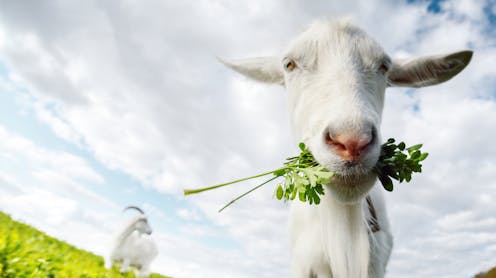Detta inlägg post publicerades ursprungligen på denna sida this site ;
Date:
Author: Rss error reading .
Original article: https://theconversation.com/no-kidding-goats-prove-brainier-than-sheep-and-alpacas-253669
When we think about intelligent animals, farm species aren’t usually the first to spring to mind. We may picture tool-using primates or puzzle-solving crows. But my recent research suggests that sheep, goats and alpacas – staples of the barnyard – deserve more credit.
In two separate studies, I tested how these animals learn, remember and make sense of the world around them. The findings reveal not only that we’ve underestimated their cognitive abilities, but also that there are important differences between species.
Of the three, goats came out on top – outperforming both sheep and alpacas in tasks testing memory and problem-solving.
Initial testing focused on spatial memory, which is the ability to remember the location of something important, like food. In the wild, this is a important survival skill. Animals need to recall where to find water, food or shelter.
I set up a simple experiment. Each animal had to locate food hidden in one of several buckets in a small arena. Once they’d learned where the food was, I changed the positions and tested how quickly and accurately they could relocate it.
Goats appeared to show the strongest spatial memory, finding the food faster and making fewer errors than the others. Sheep also performed well, although they made more mistakes than the goats. The alpacas, however, struggled to complete the tasks within the time limit.
Siam Stock/Shutterstock
This stronger spatial memory in goats could be linked to their evolutionary history. They have adapted to forage across wide, rocky landscapes and they have probably developed a sharp memory to help them navigate efficiently and return to good food sources.
The second study looked at more complex cognitive skills: object permanence, numerical competence and categorisation – all central to making sense of a changing world.
You may have tested object permanence without realising it, for example, if you’ve ever played peekaboo with a baby. This skill is knowing that an object still exists even when it’s hidden from view. It seems easy, but this ability is an important developmental milestone for humans. Other animals use object permanence to track food, predators, prey, or their own young. It’s an essential skill for survival.
So, for this experiment, I placed food under a cup and gradually made the task harder. I added empty cups, or switched the positions of the cups so the animal had to mentally track the hidden reward.
The goats again excelled at this task. They showed a higher awareness of object permanence than the sheep and alpacas, demonstrating the ability to mentally reconstruct where the hidden object was concealed.
In other tasks, all three could tell the difference between larger and smaller quantities of food, usually picking the container with more treats. But when it came to grouping shapes that looked similar, they all found it equally difficult.
Smarter than we think
Together, these studies offer evidence to dispute the idea that farm animals are not intellectually gifted. Each species has different strengths. But my research suggests that goats understand, remember and process information with greater efficiency in the abilities tested than sheep and alpacas.
Understanding how animals think isn’t just an academic exercise either – it has real-world implications. If we know more about an animal’s cognitive abilities, we can design better environments and improve their welfare. We can also better predict how they’ll behave when grazing or adapting to new surroundings.
For instance, animals with poorer spatial memory may need extra help navigating a field or enclosure. Those with higher cognitive skills may benefit from more stimulating environments that allow them to explore and solve problems.
There may be more going on in the barnyard than we often assume. So, next time you’re at a petting zoo or walking past a farm, don’t be fooled by the woolly coats and demeanour. Especially when it comes to the goats – they may just be outsmarting everyone.
Megan Quail does not work for, consult, own shares in or receive funding from any company or organisation that would benefit from this article, and has disclosed no relevant affiliations beyond their academic appointment.
